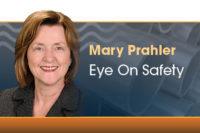Get in the know
Wholesalers should be up-to-date on revised OSHA chemical regulations.
Wholesalers
should be up-to-date on revised OSHA chemical regulations.
Currently, workplaces in the United States function under the Hazard Communication Standard 1910.1200 as published in the Code of Federal Regulations on March 11, 1994 - also referred to as HCS 1994.
This rule has been revised to be consistent with the United Nations Globally Harmonized System of Classification and Labeling of Chemicals - herein referred to as HCS 2012. The GHS is an internationally agreed upon system created by the UN. It is designed to replace the various classifications and labeling standards used in different countries by using consistent criteria for classification and labeling on a global level.
It is a comprehensive approach to defining health, physical and environmental hazards of chemicals; creating classification processes that use available data on chemicals for comparison with the defined hazard criteria; and communicating hazard information, as well as protective measures on labels and safety data sheets. The UN Conference on Environment and Development maintains a guide on GHS referred to as the “Purple Book,” which is available at www.unece.org.
OSHA modified HCS 1994 by adopting the GHS, believing it will ensure workers have access not only to labels and safety data sheets, but also to information that is easier to find and understand through the use of standardized formats and label elements such as signal words, pictograms, hazard statements and precautionary statements. As one participant stated during OSHA’s rulemaking process, “This update will give workers the right to understand, as well as the right to know.”
What do these changes mean for you and what are the timelines for implementing the changes? Employers must train workers on the new label elements and SDS format by Dec. 1, 2013. Chemical manufacturers, importers, distributors and employers must comply with all modified provisions of the final rule by June 1, 2015. However, distributors may ship products labeled by manufacturers under the old system until Dec. 1, 2015.
By June 1, 2016, employers must update alternative workplace labeling and hazard communication programs and provide worker training for newly identified physical and health hazards. During the transition period, chemical manufacturers, importers, distributors and employers may comply with either HCS 1994 or HCS 2012 or parts of both standards. Written HCS programs will have to be updated to the new standard.
HCS 2012 requires safety data sheets (formerly known as material safety data sheets) be modified to a uniform format, and include section numbers, headings and associated information as defined in the HCS 2012. Expect an influx of revised safety data sheets as manufacturers comply with the new regulations.
HCS 2012 requires labels contain pictograms, a signal word, hazard and precautionary statements, product identifier and supplier information. Supplemental information can be provided as needed.
There are two signal words in the GHS system - “Danger” and “Warning.” These words are used to communicate the level of hazard on both the label and the SDS and are set out by the classification system. For example, the signal word for self-heating substances and mixtures, Category 1 is “Danger,” while “Warning” is used for the less-serious Category 2. There also are categories where no signal word is used.
There are numerous changes to the definitions, including deletion of some familiar definitions. The hazard coding system is completely different from the previous NFS system. These changes will require changes in written HCS programs as well as placarding in transportation.
HCS requires pictograms on labels and SDS to alert users of the chemical hazards to which they may be exposed. The pictogram format is a diamond shape with a white background, black symbol and a red border and represents a distinct hazard.
For more information on SDS sheets, label requirements and the nine adopted pictograms, visit OSHA’s website at www.osha.gov. In order to provide more information on HCS 2012, the ASA Safety Committee will be sponsoring participation in a free webinar in the near future. A date and time will be published via email blasts and on the ASA website at www.asa.net.
Currently, workplaces in the United States function under the Hazard Communication Standard 1910.1200 as published in the Code of Federal Regulations on March 11, 1994 - also referred to as HCS 1994.
This rule has been revised to be consistent with the United Nations Globally Harmonized System of Classification and Labeling of Chemicals - herein referred to as HCS 2012. The GHS is an internationally agreed upon system created by the UN. It is designed to replace the various classifications and labeling standards used in different countries by using consistent criteria for classification and labeling on a global level.
It is a comprehensive approach to defining health, physical and environmental hazards of chemicals; creating classification processes that use available data on chemicals for comparison with the defined hazard criteria; and communicating hazard information, as well as protective measures on labels and safety data sheets. The UN Conference on Environment and Development maintains a guide on GHS referred to as the “Purple Book,” which is available at www.unece.org.
OSHA modified HCS 1994 by adopting the GHS, believing it will ensure workers have access not only to labels and safety data sheets, but also to information that is easier to find and understand through the use of standardized formats and label elements such as signal words, pictograms, hazard statements and precautionary statements. As one participant stated during OSHA’s rulemaking process, “This update will give workers the right to understand, as well as the right to know.”
What do these changes mean for you and what are the timelines for implementing the changes? Employers must train workers on the new label elements and SDS format by Dec. 1, 2013. Chemical manufacturers, importers, distributors and employers must comply with all modified provisions of the final rule by June 1, 2015. However, distributors may ship products labeled by manufacturers under the old system until Dec. 1, 2015.
By June 1, 2016, employers must update alternative workplace labeling and hazard communication programs and provide worker training for newly identified physical and health hazards. During the transition period, chemical manufacturers, importers, distributors and employers may comply with either HCS 1994 or HCS 2012 or parts of both standards. Written HCS programs will have to be updated to the new standard.
HCS 2012 requires safety data sheets (formerly known as material safety data sheets) be modified to a uniform format, and include section numbers, headings and associated information as defined in the HCS 2012. Expect an influx of revised safety data sheets as manufacturers comply with the new regulations.
HCS 2012 requires labels contain pictograms, a signal word, hazard and precautionary statements, product identifier and supplier information. Supplemental information can be provided as needed.
There are two signal words in the GHS system - “Danger” and “Warning.” These words are used to communicate the level of hazard on both the label and the SDS and are set out by the classification system. For example, the signal word for self-heating substances and mixtures, Category 1 is “Danger,” while “Warning” is used for the less-serious Category 2. There also are categories where no signal word is used.
There are numerous changes to the definitions, including deletion of some familiar definitions. The hazard coding system is completely different from the previous NFS system. These changes will require changes in written HCS programs as well as placarding in transportation.
HCS requires pictograms on labels and SDS to alert users of the chemical hazards to which they may be exposed. The pictogram format is a diamond shape with a white background, black symbol and a red border and represents a distinct hazard.
For more information on SDS sheets, label requirements and the nine adopted pictograms, visit OSHA’s website at www.osha.gov. In order to provide more information on HCS 2012, the ASA Safety Committee will be sponsoring participation in a free webinar in the near future. A date and time will be published via email blasts and on the ASA website at www.asa.net.
Links
Looking for a reprint of this article?
From high-res PDFs to custom plaques, order your copy today!






